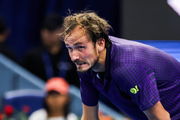
Imago
Image Credits: Amanda Anisimova/Instagram

Imago
Image Credits: Amanda Anisimova/Instagram
“The scheduling is super intense, it’s too intense. There’s no point for us to play over 20 tournaments in a year,” Iga Swiatek admitted back in June when asked about the mental health challenges players face. Her words now feel prophetic as the WTA calendar continues to pile up, with tournaments jammed one after another, even right after the exhausting grind of a Slam like the US Open. With the Asian swing looming, withdrawals are mounting, Amanda Anisimova being the latest, and frustration is boiling over. The WTA is facing brutal backlash, as players and fans alike call out the chaos of an unforgiving schedule.
Watch What’s Trending Now!
The Guadalajara Open is currently unfolding as a WTA 500 tournament on the outdoor hard courts of Zapopan, Mexico. Founded in 2022 as a WTA 1000 event, it was reclassified to the WTA 500 tier in 2024 after the city successfully hosted the 2021 WTA Finals. An important stop on the WTA Tour calendar, the tournament serves as a prelude to the Asian swing, falling just before Beijing and Wuhan, and runs from September 8 to 14.
The quarterfinal lineup is already generating buzz, featuring names like American Iva Jovic and Germany’s Tatjana Maria. One fan tweeted, “This is the quarterfinals lineup for the WTA 1̶2̶5̶ 500 in Guadalajara 🔥,” and the post went viral. Tennis reporter José Morgado shared the tweet, adding, “Great chance for everybody involved, but having a WTA 500 every week everywhere really doesn’t make any sense.”
ADVERTISEMENT
The relentless grind of post-US Open tournaments has become painfully clear this season, with Amanda Anisimova emerging as the latest high-profile victim. The American has been a constant presence on tour throughout 2025, competing at Wimbledon, Montreal, Cincinnati, and finally Flushing Meadows.
Great chance for everybody involved, but having a WTA 500 every week everywhere really doesn’t make any sense. https://t.co/MDClAFbovv
— José Morgado (@josemorgado) September 13, 2025
While fans were eager to see her maintain momentum after the US Open, her schedule has now forced a pause. The young star has withdrawn from her first post-Slam event, the Korea Open in Seoul, citing an ankle injury sustained during her New York campaign.
ADVERTISEMENT
Initially, Anisimova kept her fitness struggles under wraps, but the official Korea Open Instagram account confirmed her withdrawal, translating the reason as the “ankle injury suffered during the US OPEN.” The player later shared her own confirmation via Instagram story, saying, “I’m so sad to miss Korea this year, as I really enjoyed my time there last year. I really hope to be back next year 🥲 🤍 So sorry and see you guys there soon.” Her absence is a stark reminder of how taxing the back-to-back tournament schedule can be, even for the sport’s rising stars.
Anisimova is far from alone in feeling the strain of the packed calendar. High-profile players across the tour have also stepped back from events, forcing fans and insiders to question the sustainability of the current WTA schedule. The pressure to compete week after week, combined with the physical demands of Grand Slam play, is increasingly leaving players sidelined, raising serious discussions about scheduling reform.
ADVERTISEMENT
Naomi Osaka and Madison Keys withdraw from Billie Jean Cup
A couple of days ago, José Morgado dropped a post-US Open bombshell, revealing a talent exodus from the Billie Jean King Cup. His tweet struck like thunder: “Osaka, Keys and Zheng (this one expected) all out of the BJK Cup Finals. Initial line ups were great. Not as much anymore,” leaving fans reeling as the drama thickens ahead of the season’s close. The news underscores the mounting pressure on top players navigating a relentless WTA calendar.
Emma Raducanu has also made headlines, choosing to skip the BJK Cup Finals in favor of competing at the Korea Open. Granted a wildcard into the Seoul tournament, the British star is prioritizing her individual comeback over national duty, a strategic decision aimed at regaining form, match fitness, and climbing back into the WTA top 30 before the 2025 season.
ADVERTISEMENT
China’s top-ranked Olympic champion Qinwen Zheng has also withdrawn, with organizers confirming her absence from Shenzhen. Having undergone right elbow surgery in July and missed the US Open, her withdrawal was expected but remains a blow to the home crowd.
Top Stories
Carlos Alcaraz Makes Bold Coaching Call After Sudden Split With Juan Carlos Ferrero

Stan Wawrinka Breaks Silence on Retirement With Emotional Message After 23 Years on Tour

12-Year Ban Sends Shockwaves Through Chinese Tennis After Match-Fixing Scandal

Daniil Medvedev Brutally Defeated by World No. 524

Ben Shelton & Taylor Fritz Confirm Participation for 2026 Event in a Bid to End Career Long Curse

With Naomi Osaka and Madison Keys also out, the BJK Cup field has thinned significantly. While stars like Jasmine Paolini, Jessica Pegula, and Elena Rybakina remain, the absence of multiple top-20 players inevitably shifts the tournament’s star power and fan expectations.
The spate of withdrawals raises a broader question: should the WTA calendar see major reform to protect players, or is relentless exposure necessary to keep tennis in the fan spotlight? The tension between safeguarding athletes’ health and maintaining the sport’s appeal has never been more evident, as stars make calculated choices to survive, compete, and ultimately thrive in a punishing professional landscape.
ADVERTISEMENT
ADVERTISEMENT
ADVERTISEMENT
ADVERTISEMENT

